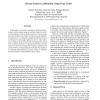Free Online Productivity Tools
i2Speak
i2Symbol
i2OCR
iTex2Img
iWeb2Print
iWeb2Shot
i2Type
iPdf2Split
iPdf2Merge
i2Bopomofo
i2Arabic
i2Style
i2Image
i2PDF
iLatex2Rtf
Sci2ools
CRV
2009
IEEE
2009
IEEE
Screen-Camera Calibration Using Gray Codes
In this paper we present a method for efficient calibration of a screen-camera setup, in which the camera is not directly facing the screen. A spherical mirror is used to make the screen visible to the camera. Using Gray code illumination patterns, we can uniquely identify the reflection of each screen pixel on the imaged spherical mirror. This allows us to compute a large set of 2D-3D correspondences, using only two sphere locations. Compared to previous work, this means we require less manual interventions, combined with a more robust screen pixel detection scheme. This results in a consistent improvement in accuracy, which we illustrate with experiments on both synthetic and real data.
| Added | 22 Jul 2010 |
| Updated | 22 Jul 2010 |
| Type | Conference |
| Year | 2009 |
| Where | CRV |
| Authors | Yannick Francken, Chris Hermans, Philippe Bekaert |
Comments (0)

